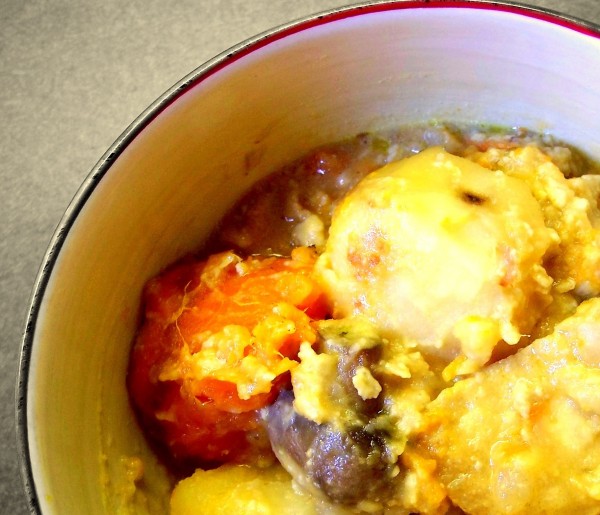 CAUTION: Don’t make this curry when you’re in a hurry. If you’ve got half a day to kill, then a trip to to the groceries and a couple of hours in the kitchen might be fun. At the groceries: grab 3-4 plump potatoes, 2-3 red yams/sweet potatoes, carrots, mushroom, yellow fried tofu, fresh gluten meat, 1 can of coconut milk. The fresh gluten meat is white, slightly layered, with a wet, bouncy texture, usually sold in packages of 2-4 blocks. Do not get the canned kind, or the kind that looks like bread. If fresh gluten meat is nowhere to be found (as happened to me at 99 Ranch Market), “vegan chicken” might substitute. At the sink: peel all potatoes, sweet potatoes, and carrots. Cut them into big chunks (at least a finger digit thick) so that they won’t just dissolve in the curry later. Cut the fried tofu and gluten meat into similarly thick chunks. At the stove: Continue reading Got time? Make vegan curry.
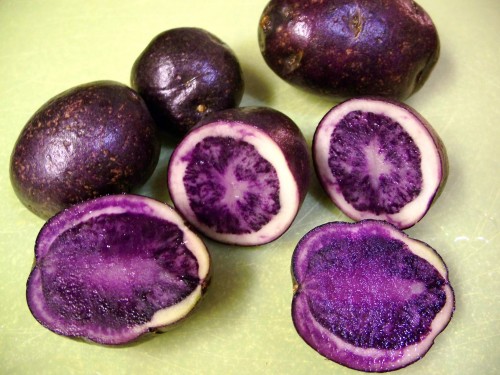 If you walk into my house you’re not gonna see many purple things. Truth is, I think purple is a picky color, even more so than pink. The wrong purple is tacky, the right purple rarely happens. But somehow all purple foods taste good (except eggplant). Purple cabbage, purple lettuce, beet, taro (mmm, taro ice cream), blueberry, purple spinach. Then I ran into purple potatoes at Lucky. I bet you can carve your initials and use it as a stamper. At first I thought they are some cross between normal potato and beet, with the beet’s juicy crunch apparent whatever way you slice. Turns out it’s a mutation that causes production of the antioxidant anthocyanin, giving it the ink-stain color. So it’s all potato. Mudpie the chef sliced them. Stir fry with salt, pepper, garlic powder, tarragon until golden. Continue reading Down the Aisles 3: Ink stamper or potato?
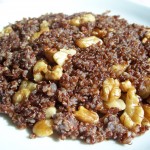 It has the texture of corn germs (the flat yellow seed inside each corn kernel). With the tiny mahogany peel cracked open just a little, each quinoa seed spills out its soft white flesh, the combination gets amusing. It’s like broken rice but more vigorous and inhomogeneous, or sesame but more fleshy. It goes well with walnuts either mixed in at the beginning or added at the end. If you think hard about it, it even tastes like clariid catfish eggs. Several ideas spring up: quinoa chè? quinoa xôi (sticky rice with quinoa or quinoa with mung bean)? quinoa bread, quinoa pie? Have you cooked with quinoa before? What is your experience with it? Continue reading Little red riding seeds
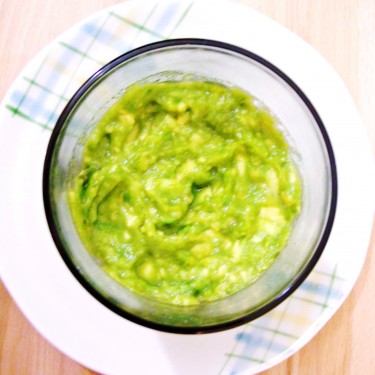 Who do you think is more confused about his identity, the penguin or the avocado? The penguin is the prime example of a bird that can’t fly. The avocado is the most commonly known fruit that doesn’t taste like a fruit. It lacks the citric hint of berries and oranges, the crunch of apples, the pulpiness of peaches and plums. If I were an avocado I’d ask myself several times a day, why did mom and dad make me taste like butter and different from every other fruitie at the market? A good avocado mom tree, like all good moms, would say “Av, being different is a good thing!”. – But I don’t get to hang out with the other fruits, they say I’m fat. – The other fruits can’t make Ice Cream by themselves. They’re only side flavors. You can become Ice Cream all by yourself. – If Sugar helps me. – Sugar is nice, but you also have what it takes to be a good Ice Cream. And think about what you can do for others if you learn from Butter and Cheese, you have their smoothness too. If I were an avocado, […]
Continue reading The avocado’s sweet side
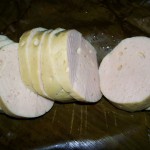 For those with not much more than a skillet and a spatula in a kitchenette (hello, grad students!), it’s best just to buy a loaf from your nearest Vietnamese sandwich shop or Asian market. Now what? Here’s a list of 13 dishes with cha lua to churn out at your castle (in no particular order), requiring no special cooking hoopla or obscure ingredients (unless silk sausage is considered an obscure ingredient). […]
Continue reading 13 recipes with cha lua
 Compared to other Vietnamese sandwich shop goodies, banana bread pudding is relatively easy to make at home, perhaps because of its strong connection with Western desserts. The ingredients contain bread, milk, rum, and vanilla, but at the end of the day, the tropical note of banana plays the key role. Ingredients: – 1 bunch of banana ~ 7-8 fingers, preferably Chuoi Su cultivar (also known as Chuoi Xiem, Pisang Siem, Siusok, Kluai Namwa Daeng) – 1.5 loaves of old stale bread (the pullman loaf to make sandwiches) – Rum (1 tbs for every 300g of banana) (optional) – 2 cups milk – 2 cups coconut milk – 2 eggs – 1 1/4 cups sugar – 4 tbs melted butter – 1 tbs vanilla (optional) Use an 8-inch (20-25 cm) cake pan, at least 2 inches (5 cm) thick so that the bread pudding has enough room to rise. Grease the pan. Continue reading Recipe for bánh chuối nướng (Vietnamese banana bread pudding)
 3 cups of rice, 3/4 lbs cha lua, 1.25 cucumbers, 3 avocados. Made 10 fat rolls of kimbap. We used long grained rice because we didn’t want to bother buying short grains, giving the rice a little more water than what the cooker says, and it’s sticky, but gotta roll quickly or the rice would dry out, perhaps in hindsight short grain would do the job better? Seasoning the rice calls for sugar, salt, and vinegar, but ubercmuc detests the taste of vinegar, hence water substituted. Inadvertently, my rolls deviate from Maangchi’s by a great distance. Cha lua (also labelled giò lụa) was bought at a local Vietnamese shop in Little Saigon, hot and fresh from the steamer. Don’t buy those frozen things at the Asian supermarkets, who knows how long they’ve been there. I cut up the cha lua and boiled the slices to lessen the nuoc-mam flavor (which is only a wisp to begin with). It is a much better meaty core than crab stick. We weren’t sure if we got nori or kim, the sheets are green instead of black, salty, and have a noticable taste […]
Continue reading Cha lua kimbap
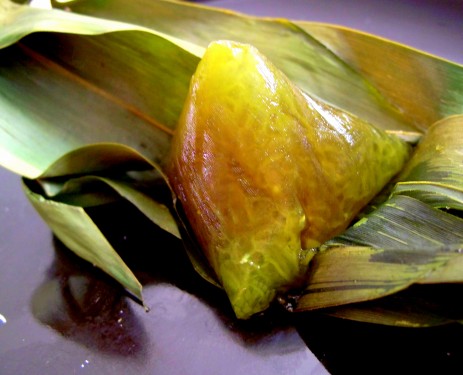 The recipe calls for a lot of prep time (up to a year!), and the products are little triangular pyramids sold for $3.75 a bunch at sandwich shops. But hey, if you can make bánh ú tro, you can enjoy it any time of the year without having to wait until the Fifth of Lunar May. 1. Ash water Use the fine, soft ash from burnt coal, dissolve in water. The common ratio is 50 grams of ash for every liter of water, but it varies depend on how strong the ash is and how strong you want your banh to be. Let the ash collect at the bottom, leaving a clear solution. Sift the solution to get rid of dirt and coal bits. You can use lime powder instead of ash. White lime gives bánh ú tro the natural green hues of wrapping leaves, red lime gives them reddish amber hues. The mixing ratio is 20 grams/liter for lime powder. Continue reading Recipe for Bánh ú tro (Vietnamese-adapted jianshui zong)
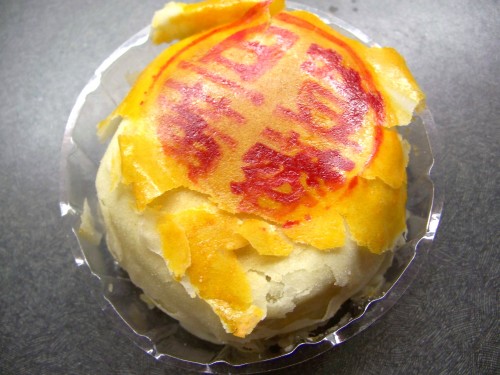 If you just want to enjoy a piece of sweet flaky mooncake, Vietnamese sandwich stores and bakeries are the place to go. If you have plenty of time at hand and little trust for unknown kitchens, then hit the market to find these ingredients for a batch of 12 bánh bía: 1. The skin dough – 375g all purpose flour (Pillsbury preferred) – 110g confectioner sugar – 80g corn/canola oil – 100ml coconut milk (Chef’ Choice preferred) – 50ml water. Continue reading Recipe for bánh bía (Vietnamese-adapted Suzhou mooncake)
|
|
Blogs we read
|










